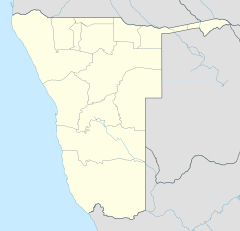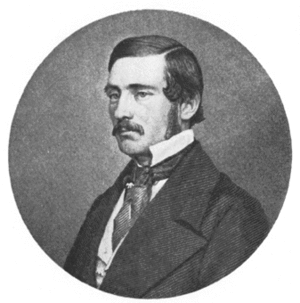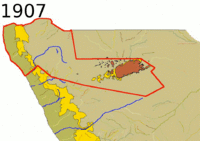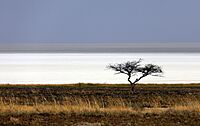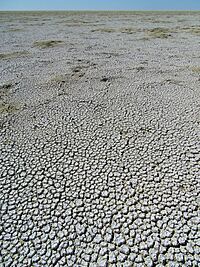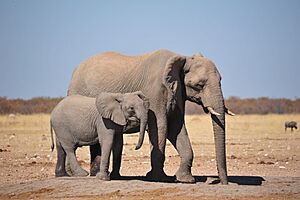Etosha National Park facts for kids
Quick facts for kids Etosha National Park |
|
|---|---|
|
IUCN Category II (National Park)
|
|
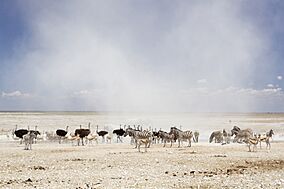
Animals gather at the Nebrownii waterhole
|
|
| Location | Namibia |
| Area | 22,270 km2 (8,600 sq mi) |
| Established | March 22, 1907 |
| Visitors | 200000 (in 2010) |
| Governing body | Ministry of Environment and Tourism, Namibia |
Etosha National Park is a huge national park in the northwestern part of Namibia. It is one of the largest and most famous parks in all of Africa. It was first created as a game reserve on March 22, 1907, by the governor of what was then German South West Africa. Later, it was officially named a national park in 1967.
The park is enormous, covering an area of 22,270 square kilometers. Its name comes from the Etosha pan, a giant, flat salt pan that is almost completely inside the park. The pan itself is so big it takes up about 23% of the park's total area.
Etosha is a safe home for hundreds of types of animals. This includes mammals, birds, and reptiles. Some of these animals are threatened or endangered, like the black rhinoceros. Protecting these animals is very important. Sadly, illegal hunting, called poaching, is a big threat. In 2022, 46 rhinos were harmed by poachers inside the park.
The park is located in the Kunene region and also borders the regions of Oshana, Oshikoto, and Otjozondjupa.
Contents
History of the Park
Long ago, different groups of people lived in and around the land that is now Etosha. The Ovambo people lived north of the great pan, and various Otjiherero-speaking groups lived just outside the park's borders. The Khoisan-speaking Hai//om people lived inside the park, near the Etosha pan.
European Explorers
The first Europeans to write about the Etosha pan were explorers Charles John Andersson and Francis Galton. They saw it on May 29, 1851. They were traveling with Ovambo traders when they came to the area.
The name Etosha comes from the Oshindonga language and means "Great White Place." This is because the huge salt pan looks like a vast, white, empty space. The Hai||om people called the pan Khubus, which means "totally bare, white place with lots of dust."
The Hai||om People
For many years, the Hai||om people lived a hunter-gatherer lifestyle in Etosha. In 1954, they were moved out of the park, which changed their way of life.
Today, the government of Namibia recognizes that the park was the traditional home of the Hai||om. Since 2004, they have had a recognized leadership group to speak for their community. The government has been working to give land back to Hai||om families on farms next to the park.
German Rule and the Park's Creation
In the late 1880s, the area was part of a German colony. German soldiers built a fort at Namutoni in 1889. In 1904, a local leader, Chief Nehale Mpingana, led an attack on the fort and destroyed it.
The fort was later rebuilt, and in 1907, the area was declared a game reserve to protect the wildlife. This was the beginning of Etosha National Park.
Changing Boundaries
The park's size has changed several times. When it was created in 1907, it was much larger and stretched all the way to the Atlantic coast. Over the years, the boundaries were redrawn. The final borders of the park as we know it today were set in 1970.
A Major Wildfire
In September 2025, a large wildfire burned through about one-third of the park. The fire was made worse by very dry conditions and strong winds. The Namibian government sent 500 soldiers to help fight the fire.
Amazing Geography
The Etosha Pan
The most famous feature of the park is the Etosha pan. It is a huge salt pan that covers about 5,000 square kilometers. It is so big you can see it from space!
Most of the year, the pan is a dry, white crust of salty clay. Not many plants can grow there. But in the summer, after heavy rains, the pan can fill with a thin layer of water. When this happens, it attracts thousands of birds like pelicans and flamingos, who come to feed and nest.
During the dry season, strong winds blow dust from the pan across the country. This dust is full of minerals that make the soil in other areas richer.
Dolomite Hills
In the southern part of the park, there are dolomite hills. One area is known as the Leopard Hills. The local name, Ondundozonananandana, means "the place where a young boy herding cattle went and never returned." This name probably came from a time when many predators like leopards lived in the hills.
Climate
Etosha has a savanna desert climate. This means it is very hot and dry. The average temperature for the year is 24°C. In the summer, temperatures can reach 40°C. In the winter, nights can be cool, dropping to around 10°C. It almost never rains during the winter.
| Climate data for Etosha Safari Lodge, Namibia (2010–2017 averages) | |||||||||||||
|---|---|---|---|---|---|---|---|---|---|---|---|---|---|
| Month | Jan | Feb | Mar | Apr | May | Jun | Jul | Aug | Sep | Oct | Nov | Dec | Year |
| Record high °C (°F) | 41.2 (106.2) |
40.2 (104.4) |
38.3 (100.9) |
36.9 (98.4) |
34.1 (93.4) |
31.9 (89.4) |
32.3 (90.1) |
36.3 (97.3) |
39.2 (102.6) |
40.9 (105.6) |
40.1 (104.2) |
41.2 (106.2) |
41.2 (106.2) |
| Mean daily maximum °C (°F) | 34.3 (93.7) |
33.5 (92.3) |
31.7 (89.1) |
31.0 (87.8) |
29.5 (85.1) |
27.4 (81.3) |
27.2 (81.0) |
30.9 (87.6) |
35.0 (95.0) |
37.2 (99.0) |
35.5 (95.9) |
34.4 (93.9) |
32.3 (90.1) |
| Daily mean °C (°F) | 25.5 (77.9) |
25.7 (78.3) |
24.0 (75.2) |
23.2 (73.8) |
21.4 (70.5) |
18.6 (65.5) |
18.0 (64.4) |
21.3 (70.3) |
25.3 (77.5) |
27.5 (81.5) |
26.6 (79.9) |
26.0 (78.8) |
23.6 (74.5) |
| Mean daily minimum °C (°F) | 18.4 (65.1) |
19.5 (67.1) |
18.0 (64.4) |
16.5 (61.7) |
13.9 (57.0) |
10.3 (50.5) |
9.6 (49.3) |
12.1 (53.8) |
15.8 (60.4) |
18.0 (64.4) |
18.3 (64.9) |
18.8 (65.8) |
15.8 (60.4) |
| Record low °C (°F) | 10.2 (50.4) |
14.3 (57.7) |
10.2 (50.4) |
9.8 (49.6) |
8.3 (46.9) |
−0.2 (31.6) |
2.6 (36.7) |
1.6 (34.9) |
2.8 (37.0) |
11.2 (52.2) |
10.9 (51.6) |
11.6 (52.9) |
−0.2 (31.6) |
| Average precipitation mm (inches) | 129.5 (5.10) |
74.9 (2.95) |
78.2 (3.08) |
28.8 (1.13) |
0 (0) |
0 (0) |
0 (0) |
0 (0) |
0.2 (0.01) |
2.1 (0.08) |
25.2 (0.99) |
79 (3.1) |
418 (16.5) |
Plants and Trees
Most of the park is a type of woodland called savanna. The most common tree is the Mopane tree, which makes up about 80% of all trees in the park.
Near the giant salt pan, only special plants can grow in the salty soil. These are called halophytes (salt-loving plants). One of these is a protein-rich grass that animals like blue wildebeest and springbok love to eat.
Other areas of the park have different types of trees and bushes, including many kinds of acacia trees, which are known for their thorns.
Wildlife in the Park
Etosha is famous for its incredible wildlife. The park is home to about 114 species of mammals, 340 species of birds, 110 species of reptiles, and 16 species of amphibians.
A long time ago, by 1881, hunting had caused many large animals like elephants and lions to almost disappear from the area. Creating the park helped these animals recover. However, some animals like the buffalo and wild dog are no longer found in the park.
Sometimes, park managers have to make difficult decisions to keep the environment healthy. During long periods without rain, called droughts, they sometimes had to reduce the number of certain animals, like zebras. This helps prevent the animals from eating all the grass and ensures there is enough food for everyone.
Mammals
Here are some of the common mammals you can see in the park.
| Mammal | Status | Fun Facts |
|---|---|---|
| African bush elephant | common | Etosha's elephants are some of the tallest in Africa. But because of a lack of certain minerals in their food, their tusks are often shorter than other elephants'. |
| Southern white rhinoceros | very rare | This rhino was brought back to the park after being gone for a long time. |
| South-western black rhinoceros | rare | Etosha is a very important sanctuary for this endangered rhino. Special programs help protect them and increase their numbers inside the park. |
| Cape buffalo | extinct | The last buffalo seen in the park was in the 1950s. |
| Angolan giraffe | common | A 2009 study suggests that the giraffes in Etosha might be their own unique subspecies! |
| Lion | common | |
| Leopard | common | |
| Cheetah | uncommon | |
| Black-backed jackal | very common | |
| Bat-eared fox | common | |
| Spotted hyena | common | |
| Meerkat | common | |
| Common warthog | common | |
| African ground squirrel | very common | |
| Honey badger | common | |
| Plains zebra | very common | |
| Mountain zebra | locally common | These are only seen in the hilly western part of Etosha. |
| Springbok | very common | |
| Black-faced impala | common | |
| Gemsbok | common | |
| Damara dik-dik | common | |
| Red hartebeest | common | |
| Blue wildebeest | common | |
| Greater kudu | common |
Birds
Etosha is a paradise for bird watchers. Here are just some of the many bird species found in the park.
|
South African ostrich
|
Rollers African hoopoe |
|
Shrikes and Bushshrikes |
See also
 In Spanish: Parque nacional Etosha para niños
In Spanish: Parque nacional Etosha para niños
- Okonjima


